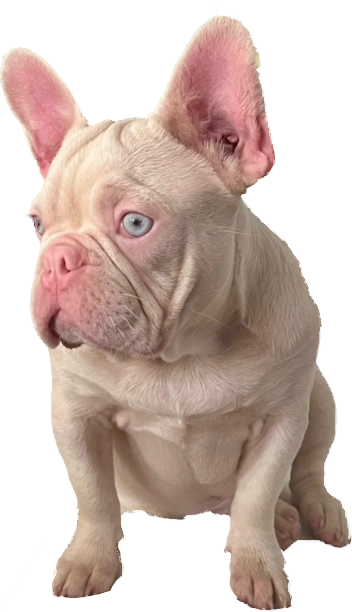Quick Summary

Click here for Price and Turnaround Time
Phenotype: Affected dogs have a white or off-white coat with pink skin, nose, lips and paw pads, and blue irises.
Mode of Inheritance: Autosomal recessive
Alleles: N = Normal, LAA = Lhasa Apso albinism
Breeds appropriate for testing: Lhasa Apso, Pomeranian, Pekingese, French Bulldog, Pug*
Explanation of results:
• Dogs with N/N genotype are not expected to display this specific albinism. They cannot transmit this LAA variant to any of their offspring.
• Dogs with N/LAA genotype are not expected to display this specific albinism but are carriers of the LAA variant. They are predicted to transmit the LAA variant to 50% of their offspring. Matings between two carriers of the LAA variant may, on average, produce 25% of puppies with the LAA albinism.
• Dogs with LAA/LAA genotypes are homozygous for the LAA variant and are expected to display the albinism phenotype. They will transmit a LAA variant to all of their offspring.
* Note: This variant was not the cause of albinism in the Pug at the time of discovery. However, since then, a phenotype of interest in the Pug, also referred to as pink, appears to be associated with this LAA variant and pink Pugs are typically genotyped as LAA/LAA.
Sample Collection
Dog DNA tests are carried out using cells brushed from your dog's cheeks and gums. The preferred cytology brushes are sent to you by mail, or you may provide your own brushes. For accepted alternative brushes, click here
We recommend waiting until puppies are at least three weeks old before testing.

Step-By-Step:
- Make sure the dog has not had anything to eat or drink for at least 1 hour prior to collecting sample.
- When swabbing puppies, isolate each puppy from the mother, littermates and any shared toys for 1 hour prior to swabbing. Puppies should not have nursed or eaten for 1 hour prior to collecting sample.
- If collecting samples from more than one dog, make sure to sample one dog at a time and wash your hands before swabbing another dog.
- Label brush sleeve with name or ID of dog to be sampled.
- Open brush sleeve by arrow and remove one brush by its handle.
- Place bristle head between the dog’s gums and cheek and press lightly on the outside of the cheek while rubbing or rotating the brush back and forth for 15 seconds.
- Wave the brush in the air for 20 seconds to air dry.
- Insert brush back into sleeve.
- Repeat steps 5 - 8 for each unused brush in sleeve on a fresh area of cheek and gums. Make sure to use and return all brushes sent by the VGL. In most cases, it will be 3 brushes per dog. If using interdental gum brushes, please note that the VGL requires 4 brushes per dog and only moderate or wide interdental gum brushes are accepted.
- Do not seal brushes in sleeve.
- Place all samples in an envelope and return to the address provided.
ATTENTION:
- Do not collect saliva/drool – the key to obtaining a good sample is getting cheek cells on the swab
- Do not rub swab on the dog’s tongue or teeth – this will result in poor quality sample
- Do not collect a sample from a puppy that has recently nursed – the mother’s genetic material can rub off on the puppy’s mouth and contaminate the sample
Albinism is a genetic disorder that is characterized by an inability to produce pigment. In oculocutaneous albinism, the skin (including nose and paw pads) and eyes lack pigmentation. As a result, dogs with albinism typically display a white or off-white coat with pink skin, nose, lips and paw pads, and blue or white irises. Note that not all dogs with white coats have albinism. In most cases, the solid white coat of dogs is caused by white spotting. Non-albino white dogs can be distinguished from true albinism because their nose, eyes, paw pads and skin display normal pigmentation.
A missense variant (c.1478G>A) in the solute carrier family 45, member 2 (SLC45A2) gene, causing a glycine to aspartic acid substitution, was identified as the cause of albinism in a Lhasa Apso dog. The variant was also identified as the cause of albinism in a Pomeranian family, a Pekingese dog and a mixed breed dog. Research at the VGL has identified this same variant in French Bulldogs (commonly referred to as pink in that breed). The C.1478G>A variant is not the cause of albinism in the Pug. However, a phenotype of interest in the Pug, also referred to as pink, appears to also be associated with this LAA variant and pink Pugs are typically genotyped as LAA/LAA.
Additional variants in SLC45A2 also cause oculocutaneous albinism in different dog breeds: a large deletion in SLC45A2 causes albinism in the Doberman Pinscher and a single base deletion in this gene causes albinism in the Bull Mastiff. Mutations in SLC45A2 have also been shown to cause oculocutaneous albinism in humans, gorillas, and cattle. Unlike with other white depigmentation patterns, no loss of hearing is associated with SLC45A2 variants.
Testing recommendations: Genetic testing for albinism can be used by owners and breeders as a tool for selection of mating pairs.
